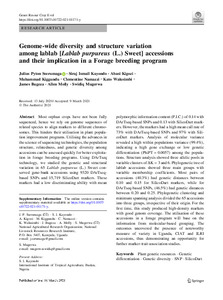| dc.contributor.author | Sserumaga, J.P. |
| dc.contributor.author | Kayondo, S.I. |
| dc.contributor.author | Kigozi, A. |
| dc.contributor.author | Kiggundu, A. |
| dc.contributor.author | Namazzi, C. |
| dc.contributor.author | Walusimbi, K. |
| dc.contributor.author | Bugeza, J. |
| dc.contributor.author | Molly, A. |
| dc.contributor.author | Mugerwa, S. |
| dc.date.accessioned | 2022-09-19T11:16:53Z |
| dc.date.available | 2022-09-19T11:16:53Z |
| dc.date.issued | 2021 |
| dc.identifier.citation | Sserumaga, J.P., Kayondo, S.I., Kigozi, A., Kiggundu, M., Namazzi, C., Walusimbi, K., ... & Mugerwa, S. (2021). Genome-wide diversity and structure variation among lablab [Lablab purpureus (L.) Sweet] accessions and their implication in a forage breeding program. Genetic Resources and Crop Evolution, 68, 2997–3010. |
| dc.identifier.issn | 0925-9864 |
| dc.identifier.uri | https://hdl.handle.net/20.500.12478/7772 |
| dc.description.abstract | Most orphan crops have not been fully sequenced, hence we rely on genome sequences of related species to align markers to different chromosomes. This hinders their utilisation in plant population improvement programs. Utilising the advances in the science of sequencing technologies, the population structure, relatedness, and genetic diversity among accessions can be assessed quickly for better exploitation in forage breeding programs. Using DArTseq technology, we studied the genetic and structural variation in 65 Lablab purpureus (L.) Sweet conserved gene-bank accessions using 9320 DArTseq-based SNPs and 15,719 SilicoDart markers. These markers had a low discriminating ability with mean polymorphic information content (P.I.C.) of 0.14 with DArTseq-based SNPs and 0.13 with SilicoDart markers. However, the markers had a high mean call rate of 73% with DArTseq-based SNPs and 97% with SilicoDart markers. Analysis of molecular variance revealed a high within populations variance (99.4%), indicating a high gene exchange or low genetic differentiation (PhiPT = 0.0057) among the populations. Structure analysis showed three allelic pools in variable clusters of ΔK = 3 and 6. Phylogenetic tree of lablab accessions showed three main groups with variable membership coefficients. Most pairs of accessions (40.3%) had genetic distances between 0.10 and 0.15 for SilicoDart markers, while for DArTseq-based SNPs, (46.5%) had genetic distances between 0.20 and 0.25. Phylogenetic clustering and minimum spanning analysis divided the 65 accessions into three groups, irrespective of their origin. For the first time, this study produced high-density markers with good genom coverage. The utilisation of these accessions in a forage program will base on the information from molecular-based grouping. The outcomes uncovered the presence of noteworthy measure of variety in Uganda, CIAT and ILRI accessions, thus demonstrating an opportunity for further marker-trait-association studies. |
| dc.description.sponsorship | National Agricultural Research Organization |
| dc.description.sponsorship | Bill & Melinda Gates Foundation |
| dc.format.extent | 2997–3010 |
| dc.language.iso | en |
| dc.subject | Plant Genetic Resources |
| dc.subject | Genetic Variation |
| dc.subject | Genetic Diversity |
| dc.subject | Single Nucleotide Polymorphism |
| dc.subject | Uganda |
| dc.title | Genome-wide diversity and structure variation among lablab [Lablab purpureus (L.) Sweet] accessions and their implication in a forage breeding program |
| dc.type | Journal Article |
| cg.contributor.crp | Roots, Tubers and Bananas |
| cg.contributor.affiliation | National Agricultural Research Organisation, Uganda |
| cg.contributor.affiliation | International Institute of Tropical Agriculture |
| cg.coverage.region | Africa |
| cg.coverage.region | East Africa |
| cg.coverage.country | Uganda |
| cg.coverage.hub | Headquarters and Western Africa Hub |
| cg.identifier.bibtexciteid | SSERUMAGA:2021 |
| cg.isijournal | ISI Journal |
| cg.authorship.types | CGIAR and developing country institute |
| cg.iitasubject | Agronomy |
| cg.iitasubject | Biodiversity |
| cg.iitasubject | Crop Systems |
| cg.iitasubject | Forestry |
| cg.iitasubject | Plant Breeding |
| cg.iitasubject | Plant Genetic Resources |
| cg.iitasubject | Plant Production |
| cg.journal | Genetic Resources and Crop Evolution |
| cg.notes | Published online: 19 Mar 2021 |
| cg.accessibilitystatus | Open Access |
| cg.reviewstatus | Peer Review |
| cg.usagerightslicense | Creative Commons Attribution 4.0 (CC BY 0.0) |
| cg.targetaudience | Scientists |
| cg.identifier.doi | https://dx.doi.org/10.1007/s10722-021-01171-y |
| cg.iitaauthor.identifier | Kayondo Siraj Ismail: 0000-0002-3212-5727 |
| cg.futureupdate.required | No |
| cg.identifier.volume | 68 |
| cg.contributor.acknowledgements | The authors would also like to thank ILRI, Adisi Ababa AND CIAT Columbia for making their germplasm available for the study. Also BecA-ILRI hub for genotyping services. |

